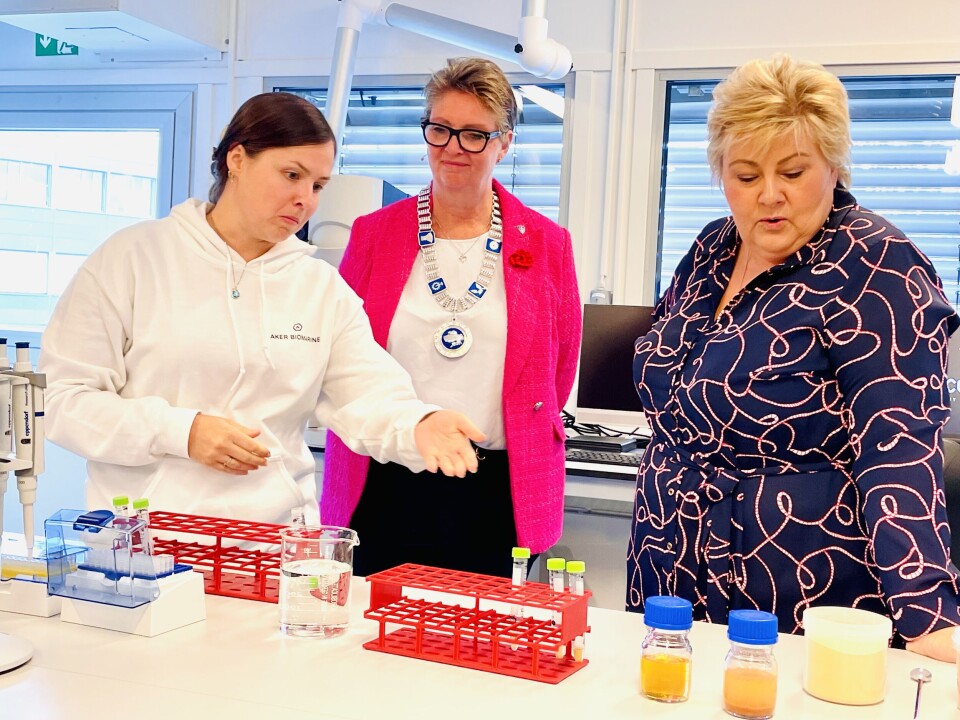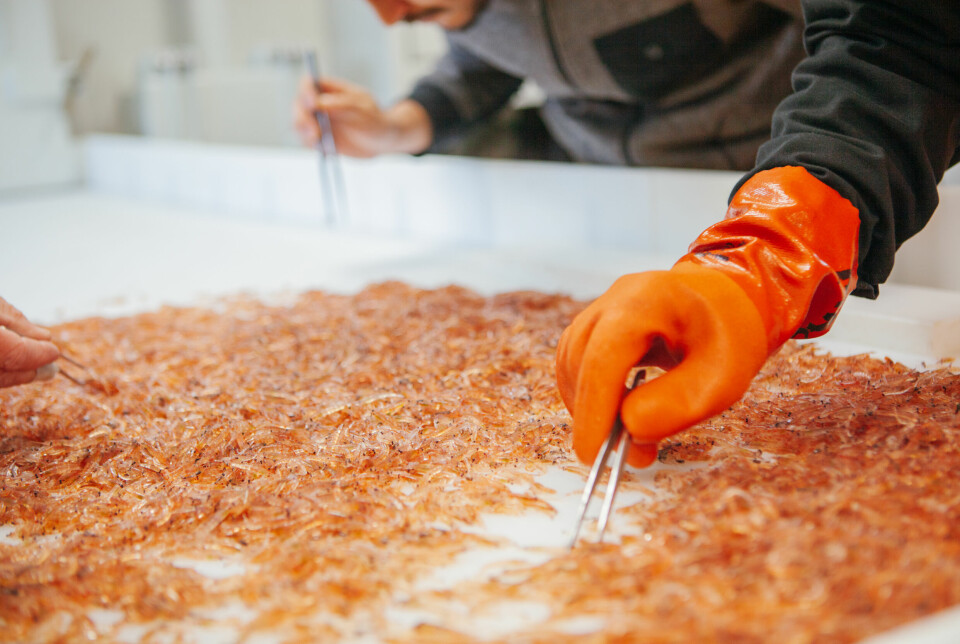
Want to sell Norwegian protein powder made from krill to the USA, Australia, and New Zealand
The small crustacean krill will now be used as a supplement in protein shakes, energy bars, and food items.
Land-based food production is under significant pressure. At Drømtorp Business Park in Eastern Norway, research is being done to extract more edible protein from marine life.
In Aker BioMarine's new pilot factory, they are producing protein supplements from krill, after years of technological research.
“It was all just pipes here,” Conservative Party leader Erna Solberg, who was present during the opening, said. She was talking about the metal pipes that cover the factory's walls and ceiling.
It smells surprisingly little of fish waste. Up in the laboratory, Solberg got to try mixing the krill powder in liquid. She also got to smell the krill powder before and after purification.
“This smells like fish, yes,” she said about the unpurified product.
What has gone through a high-tech purification process was virtually odourless.

Aker BioMarine's new protein factory
The world will need much more protein to feed the Earth’s population in 2050 than today.
Krill is one of the species that could become an important, sustainable source of protein from the ocean, the manufacturer hopes.
The pilot factory has already launched one krill product. They have gotten it approved for sale in the USA, Australia, and New Zealand. They also have an application submitted for approval in the EU and Great Britain.
“This is a first-generation high-purity protein ingredient and can be mixed into everything from drinks to enriching regular foods,” Christine Strømhylden Lunder tells sciencenorway.no.
She heads the protein initiative at Aker BioMarine's factory.
Protein drinks and foods
Protein supplements are in demand in the fitness market among those who are building muscle. However, the company believes the product can also be used in energy bars, and in nutritional supplements for the sick and elderly who need to maintain muscle mass.
“To counteract the loss of muscle mass through ageing, it’s important to get enough protein,” Lunder says.
Valuable minerals
Krill is a new protein source that has lower land use and less water consumption than traditional protein sources. Additionally, krill contains valuable minerals such as magnesium, calcium, and selenium, according to Diana Lindberg, a senior researcher at Aker BioMarine.
Krill is a small crustacean, like a tiny shrimp. The animal has a characteristic taste and smell. Producing as pure a product as possible has been challenging.
“Has it been difficult to remove unwanted odours and taste while retaining desired nutrients?”
“Yes, we have worked systematically on this to create a high-quality product without unwanted taste and smell,” the senior researcher says.
Removes fluorine
One of the challenges of using krill is that its shell contains a lot of fluorine, researchers from the Institute of Marine Research say.
“One of the truly innovative features of our new factory is that we have developed processes that enable us to produce a protein product with extremely low fluorine values,” Christine Styrømhylden Lunder at Aker BioMarine responds.
And it is of course completely safe as a nutrient for humans, she adds.
Important to commercialise research
While inaugurating the factory, Solberg emphasised that we are utilising our marine resources in a way that yields relatively little return, compared to the potential.
Research and development is therefore important in order to get more out of the resources, she said.
It is also extremely important to focus on turning research results into commercial products, she elaborated to sciencenorway.no.
“Norway needs jobs and a basis for value creation, post-oil,” Solberg said.
Solberg noted that a significant portion of the increased research funding in recent years has been allocated to areas that have industrial relevance.
She also mentioned that new businesses need to have reliable conditions set by politicians if they are going to take risks and invest.
Is sustainable, but must be monitored
Is it sustainable to extract so much krill from the ocean for human food production? Sciencenorway.no asks the Institute of Marine Research:
“Yes, it’s sustainable – but it must be closely monitored,” replies researcher Bjørn A. Krafft at the Institute of Marine Research.
The climate is changing, and the populations of many predators dependent on krill are changing, he points out.
“This must be taken into account,” he adds.
Further research on various end products
Aker BioMarine is now conducting further research to find out how to further develop the product to meet various needs and end products.
The protein factory has both its own research laboratory and analysis laboratory to make further development possible.
They also collaborate with several research environments within food and nutrition.
“We have come a long way, and every step has been followed by thorough analyses. We are now ramping up capacity to start large-scale production,” Christine Strømhylden Lunder tells sciencenorway.no.
Translated by Alette Bjordal Gjellesvik
References:
G Skaret, B A Krafft et.al.: Standing stock of Antarctic krill (Euphausia superba Dana, 1850) (Euphausiacea) in the Southwest Atlantic sector of the Southern Ocean, 2018–19. Journal of Crustacean Biology, 2021.
Bjørn A Krafft et.al.: Distribution and biomass estimation of Antarctic krill (Euphausia superba) off the South Orkney Islands during 2011–2020. ICES Journal of Marine Science, 2023.
———
Read the Norwegian version of this article on forskning.no





































